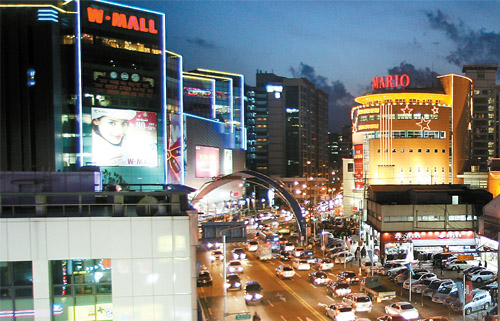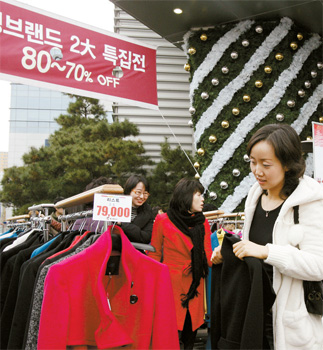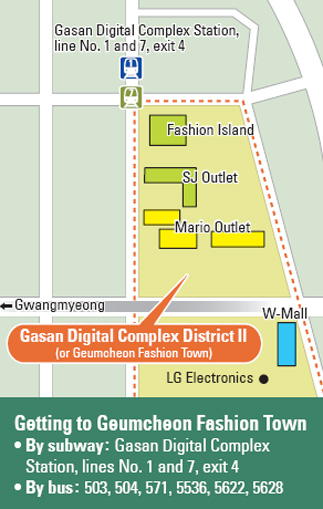Low-cost style revives Geumcheon

W-Mall, left, and Mario, right, tower over a street at Geumcheon Fashion Town, a rising fashion center in southwestern Seoul. By Jeon Min-kyu
The designation of the southwestern Seoul districts as a digital complex contributed, but clothes makers, who used to comprise the area’s biggest group of factory laborers, are also behind the transformation as they readapted for survival.
Many manufacturers based in the districts moved to China or other countries with cheaper labor, but some clothes makers stayed and became clothes sellers, cultivating the area’s image as a top fashion shopping center.
Geumcheon Fashion Town, the gem at the center, thrives due to an appealing marketing strategy previously not seen in Seoul’s fashion industry.
Stores there sell quality brands’ off-season items at low prices, a gimmick that attracts approximately 200,000 people to the area each weekend. According to managers at the area’s leading malls, the number of visitors is increasing despite the economic slowdown - or perhaps because of it.
“I come here often these days because items are cheap,” Noh Yun-mi, 28, said while hunting for a winter coat at Fashion Island, one of the major outlet stores at the fashion town, last Wednesday.
Noh, a Noryangjin resident who is preparing for the state qualification exam for public servants, came with a friend who is also job hunting.
“They are also well-known brands, not just cheap ones. The quality is credible, I guess,” Noh said.
About 570 clothes shops including dozens of multi-floor outlet malls comprise the fashion town, which sits on a 393,390-square-meter (97-acre) area in the Seoul Digital Industrial Complex II.
Wonshin World, a local clothes maker that has deep roots in the area, initiated the fashion town in 1997 by setting up a clothes shopping mall. Now known as W-Mall, it soon had rivals including Mario and Fashion Island.

Shoppers browse sidewalk displays at Fashion Island in Geumcheon Fashion Town last weekend. A banner advertises top brands on offer at discounts of 70 to 80 percent. By Jeon Min-kyu
Products by lesser-known brands are also on sale, but because of what the malls’ marketers call the “rigid quality control system,” they are kept to minimum levels.
“We rarely let in no-name brands at the risk of hurting our reputation as a premium brand outlet,” said Han Duk-hee, a marketing manager at Mario, which has three outlets at the fashion town. “It is a strategy to differentiate us from clothes sellers in Dongdaemun, Myeong-dong and other shopping areas in Seoul. People come here because of that.”
And also because of prices, Han said.
Many brand products carry expensive price tags in initial sales, but the merchants at the Geumcheon Fashion town including Mario offer them at up to 80 percent discounts in stock sales.
Such price cuts are possible, Han said, as clothes and other fashion item makers prefer disposing of items in stock at low prices for cash rather than leave them in warehouses, which itself is a financial burden for the companies.
For instance, Trebise, a golf ware shop on the third floor of Fashion Island, said it gives a 50 to 70 percent discount for clothes no older than one year. According to the shop, a golf jumper initially sold at 458,000 won ($304.30) at department stores including Hyundai Department Store sells there for 137,400 won.
“Golf apparel and gear are usually expensive to buy, but not here,” said a manager at Trebise, who asked not be identified.
Some of the shops at the fashion town are not satisfied with just being a cheaper place to shop and are groping for other ways to appeal to customers.
Sports Max at Mario II, one of the three Mario outlets, represents this trend. The store, which sells nothing but Nike shoes, has 450 different Nike lines, possibly the biggest in Korea.

Lee said even many Nike shops across the country come to buy the shoes.
“We wanted to provide something better and something new that other places in Korea cannot,” Lee said.
Such innovative thinking along with price competitiveness and a quality portfolio are behind Geumcheon Fashion Town’s rapid success. According to Geumcheon District, the town is generating approximately 1 trillion won in annual profits.
Its success, however, may wane fast. The town is facing an issue that is threatening both the town’s very survival and the livelihoods of the 30,000 to 40,000 families who depend on work there.
The area is designated as an industrial complex, and thousands of IT companies with about 100,000 workers in three digital complexes are working there.
The Korea Industrial Complex Corporation, the state-funded organization managing industrial complexes across the country, is demanding that the shops at the fashion town move out, saying that for them to do business in an industrial complex is illegal.
The corporation cites the enforcement decree of an act governing the management of industrial complexes that allows only companies in the complexes to sell items produced within the complexes. According to the decree, most of the shops selling clothes there are illegal.
The merchants at the fashion town have joined forces to solve the problem. Last year, the Geumcheon Fashion Development Council was formed to represent them. The council staged 33 protest rallies in front of the government agencies.
“This is a fashion town that no municipal government would be able to easily create,” said Park Jae-young, general manager of the council. “Tens of thousands of people live on the income from this place. The government should not overlook this fact.”
The Ministry of Knowledge Economy, the ministry concerned, is scheduled to give its final say on the issue by early next year.
By Moon Gwang-lip Staff Reporter [joe@joongang.co.kr]










with the Korea JoongAng Daily
To write comments, please log in to one of the accounts.
Standards Board Policy (0/250자)